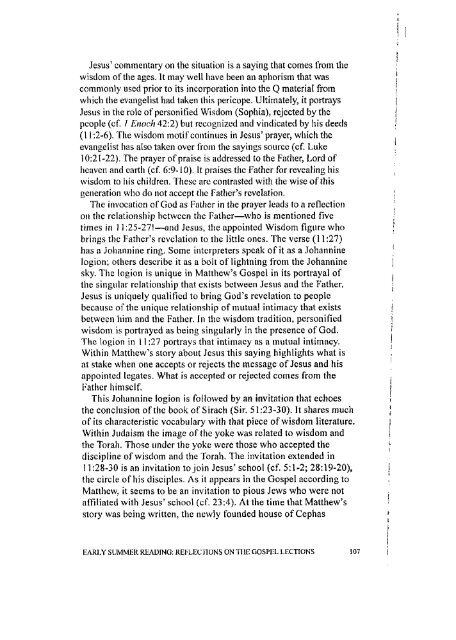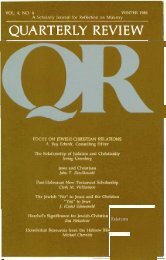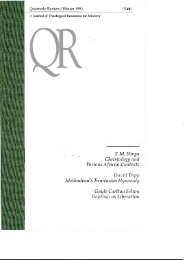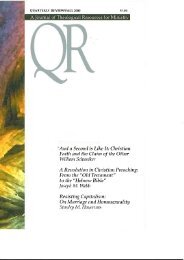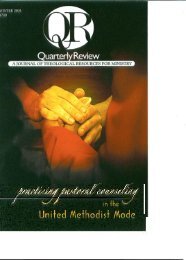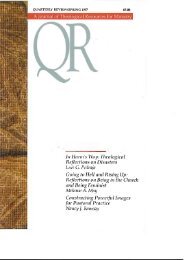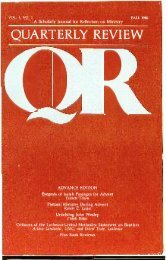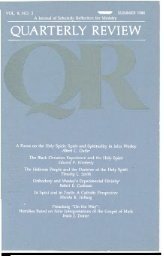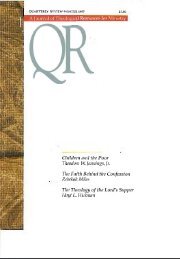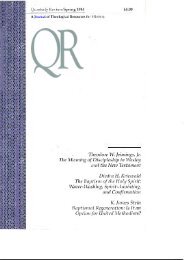Spring 1999 - Quarterly Review
Spring 1999 - Quarterly Review
Spring 1999 - Quarterly Review
You also want an ePaper? Increase the reach of your titles
YUMPU automatically turns print PDFs into web optimized ePapers that Google loves.
Jesus' commentary on the situation is a saying that comes from thewisdom of the ages. It may well have been an aphorism that wascommonly used prior to its incorporation into the Q material fromwhich the evangelist had taken this pericope. Ultimately, it portraysJesus in the role of personified Wisdom (Sophia), rejected by thepeople (cf. 1 Enoch 42:2) but recognized and vindicated by his deeds(11:2-6). The wisdom motif continues in Jesus' prayer, which theevangelist has also taken over from the sayings source (cf. Luke10:21-22). The prayer of praise is addressed to the Father, Lord ofheaven and earth (cf. 6:9-10). It praises the Father for revealing hiswisdom to his children. These arc contrasted with the wise of thisgeneration who do not accept the Father's revelation.The invocation of God as Father in the prayer leads to a reflectionon the relationship between the Father—who is mentioned fivetimes in 11:25-27!—and Jesus, the appointed Wisdom figure whobrings the Father's revelation to the little ones. The verse (11:27)has a Johannine ring. Some interpreters speak of it as a Johanninelogion; others describe it as a bolt of lightning from the Johanninesky. The logion is unique in Matthew's Gospel in its portrayal ofthe singular relationship that exists between Jesus and the Father.Jesus is uniquely qualified to bring God's revelation to peoplebecause of the unique relationship of mutual intimacy that existsbetween him and the Father. In the wisdom tradition, personifiedwisdom is portrayed as being singularly in the presence of God.The logion in 11:27 portrays that intimacy as a mutual intimacy.Within Matthew's story about Jesus this saying highlights what isat stake when one accepts or rejects the message of Jesus and hisappointed legates. What is accepted or rejected comes from theFather himself.This Johannine logion is followed by an invitation that echoesthe conclusion of the book of Sirach (Sir, 51:23-30). It shares muchof its characteristic vocabulary with that piece of wisdom literature.Within Judaism the image of the yoke was related to wisdom andthe Torah. Those under the yoke were those who accepted thediscipline of wisdom and the Torah. The invitation extended in11:28-30 is an invitation to join Jesus' school (cf. 5:1-2; 28:19-20),the circle of his disciples. As it appears in the Gospel according toMatthew, it seems to be an invitation to pious Jews who were notaffiliated with Jesus' school (cf. 23:4). At the time that Matthew'sstory was being written, the newly founded house of CephasEARLY SUMMER READING: REFLECTIONS ON THE GOSPEL LECTIONS 107


